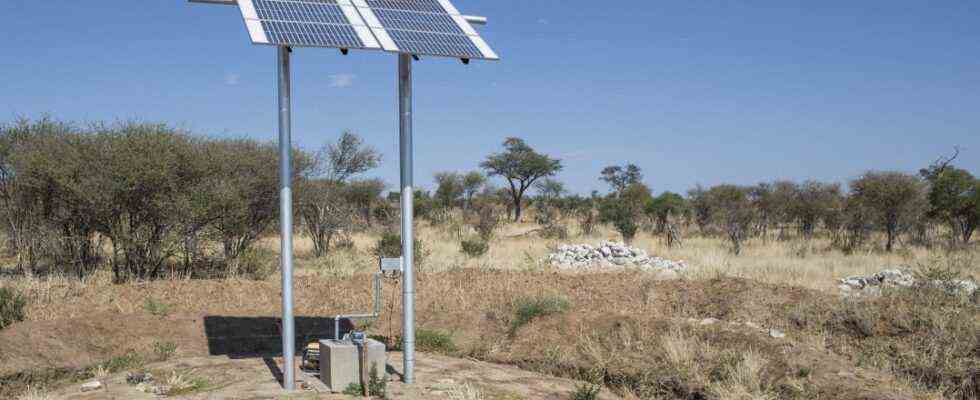The diamond fever is long gone in the hinterland of Lüderitz, a port city in southern Namibia. Where the German colonial rulers once established a restricted area in order to search for diamonds according to plan, today there is endless, almost deserted land. But a new fever has gripped southern Namibia: green hydrogen. After all, as President Hage Geingob likes to say, the country has “world-class renewable energy resources”. And he wants to use that – soon with German help. The question still remains who is actually helping whom here.
Both governments intend to sign a joint declaration this Wednesday. Germany then plans to invest up to 40 million euros in a partnership with Namibia for a feasibility study and initial pilot projects. In return, German companies and scientists are to play a “preferred role” in Namibia’s green hydrogen world. A “powerful, strategic partnership” is emerging, says Federal Research Minister Anja Karliczek (CDU), “which can shape the global energy market of the future”.
Sun and wind are abundant
Namibia is predestined for green hydrogen in many ways. With 300 days of sunshine and more than 3000 hours of sunshine, it is spoiled with solar energy even by African standards, Germany does not get half as much. There would be enough space, because Namibia is one of the most sparsely populated countries in Africa. There is also no lack of wind, at least on the coast in the south of the country. And from all this renewable electricity, water can then be broken down into oxygen and hydrogen by electrolysis. The necessary water would have to come from desalination plants, the south of Namibia is dry. There are also ports for shipping liquefied hydrogen. About the same as that of Lüderitz, or, 400 kilometers north, the deep-sea port of Walvis Bay. “The country can become a global player in green hydrogen production,” says Karliczek. A kilo of Namibian hydrogen could cost between 1.50 and two euros to produce. “A top figure worldwide,” says Karliczek. It is hardly anywhere that cheap.
Some have already cast their eyes on this potential. The port of Rotterdam, for example, which wants to become the European hub for the import of hydrogen. Or project developers like the Australian Fortescue Future Industries or CWP Global. However, Namibia has not yet entered into a partnership like that with Germany – regardless of the German colonial past, which was overshadowed by the genocide of the Herero and Nama.
The country could become an exporter of energy
Namibia itself is hoping for a whole new era in its economic development: the government puts the investment volume at six to eight billion dollars. That would correspond to around two thirds of the annual gross national product. “It’s an opportunity to industrialize this country,” says James Mnyupe, the president’s economic advisor. Not only green hydrogen, but also green ammonia can be produced in large quantities. And this can not only be used in fertilizers, but is also an interesting energy store: In the form of ammonia, energy can be transported over long distances more easily because the substance is easier to liquefy. And that as far as Europe, enthuses Mnyupe.
The agreement between the two countries is a huge opportunity, says CDU MP Stefan Kaufmann, who is the Research Ministry’s hydrogen officer. “Namibia can become an energy export country, Germany can secure Namibian hydrogen.” And at the same time, German companies could supply the associated technology. If everything goes well, the first hydrogen could be exported as early as 2025.
For the federal government, green hydrogen is a key issue; practically the entire German climate protection strategy stands and falls with green energy. Because wherever electricity cannot replace fossil energy – for example in electric motors in car traffic or in electric heat pumps for heating systems – green hydrogen is to replace coal, oil and gas in the future. It could replace coal and coke as reducing agents in steelworks and make the chemical industry climate-friendly. It could run trucks or locomotives using fuel cells and make planes fly using synthetic fuels. Even ships would no longer have to rely on diesel.
The catch: only part of it can be produced in Germany. In its hydrogen strategy, the federal government assumes a requirement of between 90 and 110 terawatt hours of hydrogen by 2030. But only 14 terawatt hours could be covered by domestic renewable energies. For the year 2045, when Germany ultimately does not want to cause any more emissions, the Climate Neutrality Foundation estimates the requirement at 260 terawatt hours. But two thirds of that would have to be imported. Berlin is currently feverishly looking for partners all over the world.
Presidential advisor Mnyupe knows that. The government wants to put the plans in concrete terms by the next climate conference in Glasgow in November – in order to be able to present them to the rest of the international community there. “We are a David among all Goliaths,” he says. “But we can help many to get closer to climate neutrality.” Germany too.

